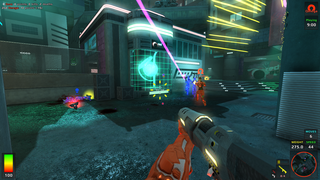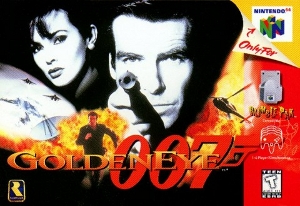Related Research Articles

Quake III Arena is a 1999 multiplayer-focused first-person shooter developed by id Software. The third installment of the Quake series, Arena differs from previous games by excluding a story-based single-player mode and focusing primarily on multiplayer gameplay. The single-player mode is played against computer-controlled bots. It features music composed by Sonic Mayhem and Front Line Assembly founder Bill Leeb.

Quake is a first-person shooter game developed by id Software and published by GT Interactive. The first game in the Quake series, it was originally released for MS-DOS, Microsoft Windows, and Linux in 1996, followed by Mac OS and Sega Saturn in 1997 and Nintendo 64 in 1998.

Deathmatch, also known as free-for-all, is a gameplay mode integrated into many shooter games, including first-person shooter (FPS), and real-time strategy (RTS) video games, where the goal is to kill the other players' characters as many times as possible. The deathmatch may end on a frag limit or a time limit, and the winner is the player that accumulated the greatest number of frags.

GoldenEye 007 is a 1997 first-person shooter video game developed by Rare and published by Nintendo for the Nintendo 64. It is based on the 1995 James Bond film GoldenEye, with the player controlling the secret agent James Bond to prevent a criminal syndicate from using a satellite weapon. They navigate a series of levels to complete objectives, such as recovering or destroying objects, while shooting enemies. In a multiplayer mode, up to four players compete in several deathmatch scenarios via split-screen.

Perfect Dark is a 2000 first-person shooter developed and published by Rare for the Nintendo 64. The first game of the Perfect Dark series, it follows Joanna Dark, an agent of the Carrington Institute research centre, as she attempts to stop an extraterrestrial conspiracy by rival corporation dataDyne. The game features a campaign mode where the player must complete a series of levels to progress through the story, as well as a range of multiplayer options, including a co-operative mode and traditional deathmatch settings with computer-controlled bots.

Unreal Tournament 2004 is a first-person arena shooter video game developed by Epic Games and Digital Extremes. Part of the Unreal franchise, it is the third game in the Unreal Tournament series and the updated version of Unreal Tournament 2003.
TimeSplitters 2 is a first-person shooter video game, developed by Free Radical Design, published by Eidos Interactive, and released in October 2002 for PlayStation 2, Xbox and GameCube. The game's story focuses on the efforts of a space marine who seeks to recover powerful time crystals from a race of alien mutants called TimeSplitters, which leads them to taking on the form of an individual dealing with their own problems across different time periods between the 19th and 25th century. The developers focused on expanding the story element following 2000's TimeSplitters, and features influences from various film genres, including horror, action and science fiction.

GoldenEye: Rogue Agent is a first-person shooter video game in the James Bond franchise, developed by EA Los Angeles and published by Electronic Arts. The player takes the role of an ex-MI6 agent, who is recruited by Auric Goldfinger to assassinate his rival Dr. No. Several other characters from the Bond franchise make appearances throughout the game, including Pussy Galore, Oddjob, Xenia Onatopp and Francisco Scaramanga.

The World Is Not Enough is a first-person shooter video game developed by Eurocom and based on the 1999 James Bond film of the same name. It was published by Electronic Arts (EA) and released for the Nintendo 64 on October 17, 2000, shortly before the release of its PlayStation counterpart. The game features a single-player campaign in which players assume the role of secret agent James Bond as he fights to stop a terrorist from triggering a nuclear meltdown in the waters of Istanbul. It includes a split-screen multiplayer mode where up to four players can compete in different types of deathmatch and objective-based games.

Action Quake 2 is a mod for the video game Quake II created by The A-Team. Action Quake 2 was developed to recreate the look and feel of an action movie, having a fast pace and a semi-realistic damage system. It features many maps recreating realistic settings, such as city streets and office buildings, with a balanced range of weapons and equipment inspired by action movies.
Soldat is a 2D multiplayer video game for Microsoft Windows. It is a run and gun game influenced by Liero and Scorched Earth, combined with elements from Counter-Strike and Worms.

Turok 2: Seeds of Evil is a first-person shooter video game developed by Iguana Entertainment and published by Acclaim Entertainment. It was released for the Nintendo 64 console in 1998 and ported to Microsoft Windows computers in 1999. Seeds of Evil is the second game in the Turok video game series and a sequel to Turok: Dinosaur Hunter. The game follows the story of a Turok and his efforts to stop a powerful alien entity from escaping the confines of his Lightship. A different game set in the same fictional universe, also titled Turok 2: Seeds of Evil, was released for the Game Boy Color alongside the Nintendo 64 game.

Half-Life 2: Deathmatch is a multiplayer first-person shooter video game developed by Valve. Released on Steam on November 30, 2004, it uses many of the assets from Half-Life 2 and its Source engine. It features new levels, optimized for multiplayer arena play, and a few new weapons. Also included are portions of the game's source code, which were the basis for many early Source-based multiplayer modifications. The game is the successor to the popular multiplayer component of the original Half-Life, but is offered as a separate product from Half-Life 2. Deathmatch, like Half-Life's multiplayer, does not develop any part of the plot or story of the Half-Life series.

Turok: Rage Wars is a first-person shooter video game developed by Acclaim Studios Austin and published by Acclaim Entertainment. It was released for the Nintendo 64 video game console in 1999. Rage Wars is a game in the Turok video game series, with a heavy emphasis on multiplayer. It supports a maximum of four players simultaneously via split-screen. The game also supports the Nintendo 64 Expansion Pak for high-resolution graphics, but does not require it. A separate game, also titled Turok: Rage Wars, which is set in the same universe but features a different gameplay and storyline, was released for the Game Boy Color in 1999.

Fired Up is a vehicular combat video game developed by London Studio and published by Sony Computer Entertainment for the PlayStation Portable. It was only released in PAL territories. The game features a single-player campaign and a multiplayer mode which supports up to eight players. The game features demos of Wipeout Pure and MediEvil: Resurrection.

Nerf Arena Blast is a first-person shooter developed by Visionary Media, Inc. and published by Hasbro Interactive, released under their Atari Interactive label. The game, based on Nerf, was touted as a "family-friendly version of multiplayer combat games like Quake III: Arena and Unreal Tournament", and was supported by Hasbro Interactive until that company gave its rights and properties over to Infogrames. The cutscenes were animated by Mondo Media alongside them doing the in-game art.

Warhawk was a 2007 online multiplayer third-person shooter video game developed by Incognito Entertainment and published by Sony Computer Entertainment for the PlayStation 3. It was intended to be a remake of an aerial warfare game of the same name, which was an early title on the original PlayStation. It was the first PlayStation 3 game to be available both physically and digitally on the PlayStation Network.

Medal of Honor Heroes 2 is a 2007 first-person shooter video game for the Wii and the PlayStation Portable. It is the 12th installment in the long-running Medal of Honor series of World War II games, and a direct sequel to the PSP-exclusive Medal of Honor: Heroes, released a year prior. Each version was built from the ground up for its respective system. Medal of Honor: Heroes 2 is set in World War II, starting on the Normandy beaches trying to control German bunkers and then move on to secure a village in France.

GoldenEye 007 is a 2010 first-person shooter video game developed by Eurocom and published by Activision for the Wii, with a handheld version for Nintendo DS developed by n-Space. It is a modern reimagining of the 1995 James Bond film GoldenEye as well as a remake of the 1997 video game of the same name, developed for the earlier Nintendo 64 console. The game was officially announced by Nintendo at their E3 2010 conference presentation. The game was released on 2 November 2010 in tandem with another James Bond game, Blood Stone, which was also released for the DS, but not the Wii. Nintendo, the publisher of the Nintendo 64 game, published the Wii version in Japan the following summer, where it remains Wii-exclusive. It was the fifth James Bond game developed by Eurocom and their second under Activision, after the PlayStation 2 version of 007: Quantum of Solace two years prior.
Hawken is a free-to-play multiplayer mech first-person shooter video game. The game features five game modes: Team Deathmatch, Deathmatch, Co-op Bot Team Deathmatch, Siege, and Missile Assault. It follows the freemium model of game monetization, where in-game purchases are the main source of revenue.
References
- ↑ Senior, Tom (2010-12-13). "GoldenEye: Source released". PC Gamer. Archived from the original on 2015-09-22. Retrieved 2015-07-05.
- ↑ Plunkett, Luke (2010-12-14). "There's A PC Remake Of GoldenEye Out Too, You Know". Kotaku. Archived from the original on 2013-01-27. Retrieved 2015-07-05.
- ↑ dudesterravensfan (2012-08-29). "Should You Play It? Goldeneye Source (Half-Life 2 Mod)". ScrewAttack. Archived from the original on 2013-08-31. Retrieved 2015-07-05.
- ↑ Miller, Ross (May 29, 2006). "R.I.P. Nickster, gone but not forgotten [update 2]". Engadget . Archived from the original on December 5, 2021. Retrieved March 4, 2021.
- ↑ Devore, Jordan (August 11, 2016). "GoldenEye: Source is still around and it's about to be updated". Destructoid. Archived from the original on August 26, 2016. Retrieved August 24, 2016.
- ↑ Prescott, Shaun (August 11, 2016). "GoldenEye: Source receives first major update since 2013". Archived from the original on August 15, 2016. Retrieved August 24, 2016.
- ↑ "GES Update 10/07/10 [4.1 Media #1] news - GoldenEye: Source mod for Half-Life 2". Mod DB. 25 December 2005. Archived from the original on 2015-09-24. Retrieved 2016-02-14.
- ↑ "About Sole Signal". www.solesignalmusic.com. Archived from the original on 2010-02-07. Retrieved 2016-02-14.
- ↑ "GoldenZen music | About". www.goldenzen-music.ch. Archived from the original on 2016-06-09. Retrieved 2016-02-14.
- ↑ Editor's Choice - Mod of the year Archived March 31, 2008, at the Wayback Machine
- ↑ Craig Pearson (2014-01-01). "Ten top fan-remade classics you can play for free right now". PC Gamer. Archived from the original on 2017-06-16. Retrieved 2017-06-08.